We Hope You Enjoy Your Christmas Cartesian Diver
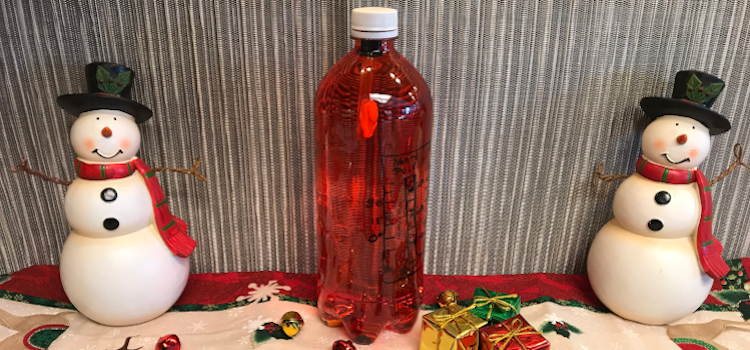
There’s a good chance that you and your kids have already seen a Cartesian diver or two, but with our holiday twist on this classic experiment, it may be time to teach your kids about buoyancy and the ideal gas law once again. We tested several divers with different size bottles of water, and added a surprise twist, to design a challenging Christmas Cartesian diver your kids will love to build this holiday season.
Christmas Cartesian Diver Printable Instructions
Go Straight to the Christmas Cartesian Diver Step by Step Instructions
The Science Behind Our Christmas Cartesian Diver
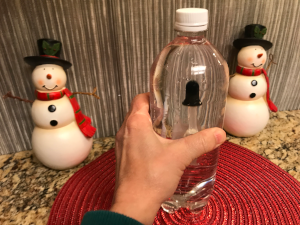
Our Christmas Cartesian diver experiment is an ideal experiment for your kids, young and old. Your younger kids will be able to observe density, pressure, and buoyancy in action as they control their diver’s movements, while your older kids will be able to use this experiment to observe the ideal gas law, Pascal’s Law, and Archimedes’ principle at play.
We designed our Cartesian diver with an eyedropper for the diver, which floats at the top of a sealed plastic bottle filled with water. In a nutshell, when you squeeze the sides of the bottle, the diver sinks to the bottom. When you stop squeezing the bottle, the diver rises back to the top.
But why does the diver sink? And how does it rise back to the top? With so much at play in this experiment, we decided to break it down into a series of steps for a better understanding of the science involved.
Squeezing the Sides of the Bottle
- When you squeeze the sides of the bottle, the pressure inside the bottle increases.
- This increase in pressure is applied to everything in the bottle, including the Cartesian diver.
- When the sides of the bottle are squeezed hard enough, the increase in pressure compresses the air bubble inside the diver, allowing more water to be pushed into the opening at the bottom of the diver.
- Since water is denser than air, the additional water in the diver increases the diver’s density.
- The diver is now denser than the water around it, weighing more than the water it displaces. Once the diver’s weight exceeds the buoyant force on it, the diver will sink.
Releasing the Sides of the Bottle
- When the sides of the bottle are released, the pressure inside the bottle will decrease.
- This decrease in pressure is applied to everything in the bottle, including the eyedropper, decompressing the air bubble inside the dropper.
- The decompressing air bubble inside the eyedropper will now push that extra water out of the dropper.
- With the removal of the extra water from the eyedropper, the dropper will no longer be denser than the surrounding water.
- Buoyancy is the force on the diver that makes it rise back to the top.
Showing Your Kids How The Christmas Cartesian Diver Works
If you’d like to give your kids a visual presentation on how our Christmas Cartesian diver works just follow these steps:
- Remove the eyedropper from a working Cartesian diver.
- Add 4 drops of red food coloring to the bottle of water, place the cap back on the bottle, and gently shake it until the water is completely colored.
- Keep clear water in the eyedropper and place it back in the bottle, making sure to replace any water that may have spilled out in Step 1.
- Have your kids squeeze and release the sides of the bottle a few times.
- Before you remove the eyedropper, ask your kids to predict what they think happened to the water inside the dropper. If necessary, remind them that water is pushed into the dropper each time they apply enough pressure.
- Remove the eyedropper from the bottle so your kids can see whether their predictions are correct.
- They should be able to see that the water in the eyedropper is turning pink, and the more times they squeeze and release the sides of the bottle, the darker the water will get.
Christmas Cartesian Diver Glossary
| Buoyancy | In this experiment, buoyancy is the force on the eyedropper that makes it move upward in the surrounding water. |
| Density | In this experiment, the density of the eyedropper is how much space it takes up (its volume) in relation to the amount of matter it has (its mass). Density = mass/volume. |
| Pressure | In this experiment, pressure is the force applied to the bottle. Pressure = Force / Area. |
| Archimedes' Principle | In this experiment, the Archimedes' Principle states that the eyedropper, whether partially or completely submerged in the water, is buoyed up with a force equal to the weight of the fluid it displaces. |
| Ideal Gas Law | In this experiment, the ideal gas law states that when the pressure on the bottle increases, the volume of air inside the eyedropper decreases. ideal gas law: PV = nRT Where P = pressure, V = volume, n = number of moles of gas, R = universal gas constant, and T = temperature. |
| Pascal's Law | In this experiment, Pascal's Law states that any pressure applied to the water inside the bottle will transmit equally throughout the water, including onto the eyedropper. |
Christmas Cartesian Diver Experiment
Tools/Supplies
| Supplies | Tools |
|---|---|
| Water | Toothpick |
| Food Coloring | Cup of Water |
| Clear Plastic Bottle | Sharpie Pens |
| Eye Dropper | |
| Putty | |
| Christmas Bells (Variety of sizes if possible) | |
This table lists the materials and tools we used for our Christmas Cartesian diver, but this experiment will work with a variety of other materials as well. Check out our Christmas Cartesian Diver Challenges section for additional ideas.
Investigation
Testing the different bottles & eyedroppers for our Christmas Cartesian diver experiment was remarkably fun, and surprisingly rewarding. We sometimes forget how fun it can be to just set everything else aside and enjoy some hands-on experimenting.
We hope our investigation helps you and your kids enjoy these Christmas Cartesian divers as much as we did.
Bottle
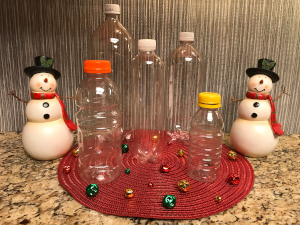
The first step in our investigation was to decide on the type of container we wanted to use. We decided to test several clear plastic bottles of various sizes because bottles are easy to find, they don’t break, and the cap allows your kids to transport their Christmas Cartesian diver without spilling any water.
The Winner
A 1-liter soda bottle from any grocery store when making the Christmas Cartesian diver, but if you want to go smaller when testing alternative liquids (see our Challenges Tab), the 17 fl oz Sparkling Ice bottle is a good choice.
Investigation Results
![]() The 2-liter soda bottle does work, but we had to squeeze very hard to make our diver sink. The smaller bottles are a much better choice for kids.
The 2-liter soda bottle does work, but we had to squeeze very hard to make our diver sink. The smaller bottles are a much better choice for kids.
![]() We were able to make our diver sink in the 1-liter soda bottle and 17 fl oz Sparkling Ice bottle with little effort, which is ideal for smaller hands.
We were able to make our diver sink in the 1-liter soda bottle and 17 fl oz Sparkling Ice bottle with little effort, which is ideal for smaller hands.
![]() Be sure to completely fill the bottle before putting the cover back on.
Be sure to completely fill the bottle before putting the cover back on.
![]()
Even though the Gatorade and apple juice bottles were small, the thicker plastic on the sides was too hard to squeeze.
Diver
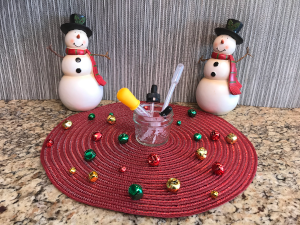
A diver is a buoyant object that contains an air bubble and just enough liquid to float near the top of a container of liquid. We decided to use eyedroppers, but you can also use ketchup packets, pen caps, or even a piece of a plastic straw bent in half that is held together with a paperclip.
The Winner
A small plastic eyedropper, preferably labeled with measurements.
Investigation Results
![]() The plastic eyedroppers need some weight added to the bottom tip area, otherwise, it will float sideways in the water. We found that some mounting (tacky) putty worked great as a weight, because it was easy to adjust the amount used, and it doesn’t dissolve in the water.
The plastic eyedroppers need some weight added to the bottom tip area, otherwise, it will float sideways in the water. We found that some mounting (tacky) putty worked great as a weight, because it was easy to adjust the amount used, and it doesn’t dissolve in the water.
![]() Be sure to check the width of the plastic bulb at the top of any eyedropper you’re looking to buy. Some of the droppers have a bulb larger than the opening at the top of your bottle.
Be sure to check the width of the plastic bulb at the top of any eyedropper you’re looking to buy. Some of the droppers have a bulb larger than the opening at the top of your bottle.
![]() We purchased two different packs of eyedroppers from Amazon, tested them, and only found 1 out of 40 droppers tested that didn’t hold water.
We purchased two different packs of eyedroppers from Amazon, tested them, and only found 1 out of 40 droppers tested that didn’t hold water.
![]() It’s easier to test if your diver will hover at the top of your container using a clear glass of water first. Otherwise, you may find yourself having to empty your bottle of water just to remove the eyedropper from the bottom.
It’s easier to test if your diver will hover at the top of your container using a clear glass of water first. Otherwise, you may find yourself having to empty your bottle of water just to remove the eyedropper from the bottom.
![]() Toothpicks are an easy way to carefully remove the eyedropper as it floats near the top of the bottle.
Toothpicks are an easy way to carefully remove the eyedropper as it floats near the top of the bottle.
![]() If you can find an eyedropper with measurements marked on it, your kids can use the measurements to analyze and record the amount of water needed to float vs the amount of water needed to sink the dropper.
If you can find an eyedropper with measurements marked on it, your kids can use the measurements to analyze and record the amount of water needed to float vs the amount of water needed to sink the dropper.
![]() Plastic eyedroppers work better with younger kids because the glass droppers can break.
Plastic eyedroppers work better with younger kids because the glass droppers can break.
Step by Step Instructions
Step 1: Supplies
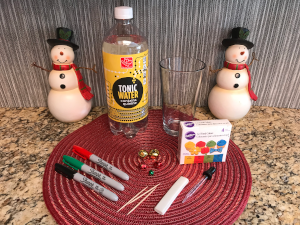
1.1 Your kids can build a Cartesian diver with just a 1-liter soda bottle, an eyedropper, and some mounting putty. If you’re helping them build our Christmas Cartesian diver, the rest of the supplies listed in our Tools/Supplies Tab will upgrade their Cartesian diver with a festive holiday twist (see Figure 1.1).
Step 2: Preparation
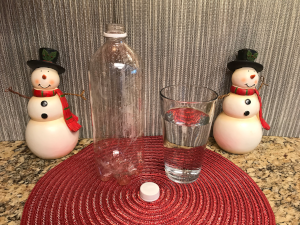
2.1 If they haven’t already done so, have your kids empty and rinse out the contents of their 1-liter soda bottle.
2.2 Help them remove any labels, price tags, or other materials that could interfere with the view inside the bottle.
2.3 Finally, have your kids fill a glass with water. The glass of water will be used to test their eyedroppers throughout the project (see Figure 2.1).
Step 3: Testing
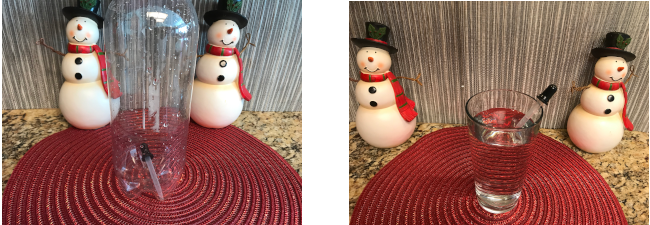
3.1 Make sure your kids verify that their eyedropper will fit through the neck of their bottle (see Figure 3.1).
3.2 Next, your kids need to test their eyedropper for any leaks. Have them partially fill their eyedropper with water using the glass they filled earlier. The eyedropper should be able to hold the water without it draining out of the bottom (see Figure 3.2).
Note: If the water leaks out, there’s a problem with the bulb on top. First, check to see that the bulb is attached properly, then have your kids test the dropper again. If the water continues to drain out the bottom, they’ll need a new eyedropper.
Step 4: Build Steps
You’ve gathered the needed tools and supplies, and you’ve walked your kids through the necessary prep work. Now it’s time for them to follow the steps below to build their own Christmas Cartesian diver.
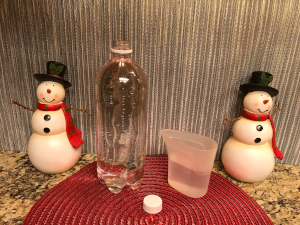
4.1 Fill your 1-liter bottle with water (see Figure 4.1).
Note: We prefer to stop filling our bottles about an inch from the top. This will prevent any displaced water from spilling as you add your eyedropper.
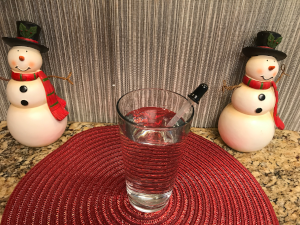
4.2 Fill your eyedropper with water using the glass you filled earlier. Set your dropper halfway in the water, squeeze the bulb to remove any air in it, then release the bulb. You should see some water get sucked up into the dropper (see figure 4.2).
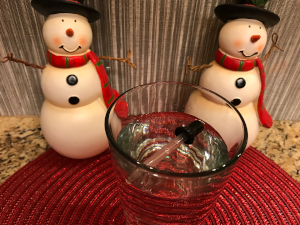
4.3 Now test the buoyancy of your eyedropper using the glass of water. If your eyedropper floats on its side as seen in Figure 4.3, continue to Step 4.4 to add weight to the bottom of your dropper. If your eyedropper is already hovering vertically near the top of the water in the glass (see Figure 4.5), you can skip to Step 4.5.
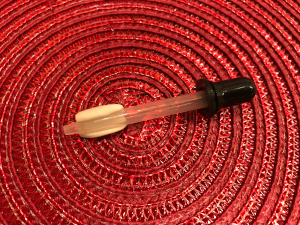
4.4 If your eyedropper floated on its side in the previous step, you need to add some weight to the end of your dropper. As discussed in our Investigations Tab, we prefer to use mounting putty. Attach a small amount of putty (or other weight) to the end of your dropper leaving one side visible. This will allow you to see what’s happening inside the dropper when you use your Cartesian diver (see Figure 4.4).
Note: The more putty you can add to the dropper now the easier it will be to make it sink when you squeeze the sides of the bottle in Step 4.7.
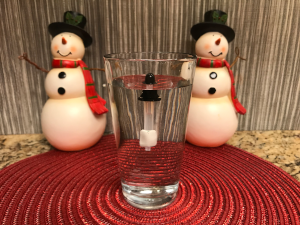
4.5 If your eyedropper continues to float on its side, add a little more putty until it hovers vertically near the top of the water (see Figure 4.5).
Note: If your eyedropper sinks to the bottom of your glass, too much weight was added. Remove a small amount of putty, and continue to run tests, until your diver hovers at the top of the water (see Figure 4.5).
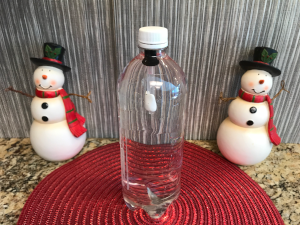
4.6 You can now place the eyedropper into your bottle of water. Add any additional water needed to fill the water to the very top of the bottle, then securely place the cap back on(see Figure 4.6).

4.7 It’s time to see your Cartesian diver in action. Squeeze the sides of your bottle firmly until the eyedropper sinks. Release the sides of your bottle to watch the eyedropper rise back to the top (see Figure 4.7).
Note: Don’t panic if you’re unable to make the eyedropper sink no matter how hard you squeeze the sides of the bottle. We built and rebuilt quite a few Cartesian divers to test for any issues and discovered two common problems.
Issue 1: Not enough water in the bottle.
Solution: Check to make sure you remembered to top off the water in the bottle after adding your eyedropper.
Issue 2: The eyedropper isn’t heavy enough.
Solution: Go back to Step 4.4 to see if you can add more putty to the bottom of the dropper without it automatically sinking in the glass of water.
** Remember, the eyedropper sinks as soon as it’s denser than the water that surrounds it, so the heavier you can make your diver, the less pressure needed to sink it.
It’s now time to add our Holiday Twist to this classic experiment!
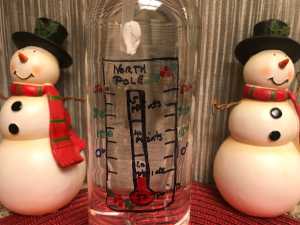
4.8 Our first Holiday Twist, Diver Hovering, is a game of precision using your hovering skills. Our North Pole thermometer has been divided into four sections, with each section worth more points than the previous one.
Practice hovering your diver between the marked areas. Challenge your family and friends to see who can earn the most points after a pre-determined number of rounds (see Figure 4.8).
Feel free to use any point system or design you want. If you’d like to use our thermometer design and point system, the values are:
- 5 points for hovering your diver between 50 degrees down to 30 degrees.
- 10 points for hovering your diver between 30 degrees and 0 degrees.
- 20 points for hovering your diver between 0 degrees and – 10 degrees.
- 25 points for hovering your diver anywhere in the red section at the bottom of the thermometer.
To make this game more challenging, add a minimum hover time the diver must stay within the marked areas. Even more challenging, try to hover the diver in a sequence of pre-determined sections.
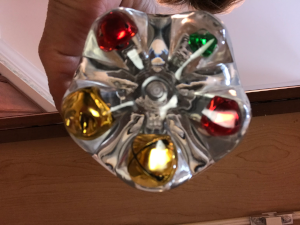
4.9 Our second Holiday Twist, Bell Ringing, is a game of chance. Add Christmas bells in a variety of colors and sizes to the bottom of your bottle. Assign point values based on how many bells you have of each color and size.
Practice sinking your diver until it touches a bell every time. Challenge your family and friends to see who can earn the most points after a pre-determined number of rounds (see Figure 4.9).
The point system for our bells was:
- 5 points for touching one of the two large gold bells.
- 10 points for touching one of the two medium red bells.
- 25 points for touching the single small green bell.
To make this game more challenging, limit the number of tries allowed each turn. You can also shake the bottle between rounds to change the position of the bells.
We Hope You Enjoy Your Christmas Cartesian Diver!
Challenges
Your kids have finished building their Christmas Cartesian diver. They’ve had fun challenging their family and friends with our Holiday Twists. Now let’s see if they’re ready to take their Cartesian diver knowledge to the next level.
- Do different types of liquid affect the amount of pressure needed to make the diver sink?
- Will a larger bottle require a different amount of pressure to make the diver sink?
- What other materials could your kids make a workable diver out of (see our investigation into divers in the Investigation Tab for a list of options)?
Help your kids use their creativity and critical thinking skills to see what they can come up with.
